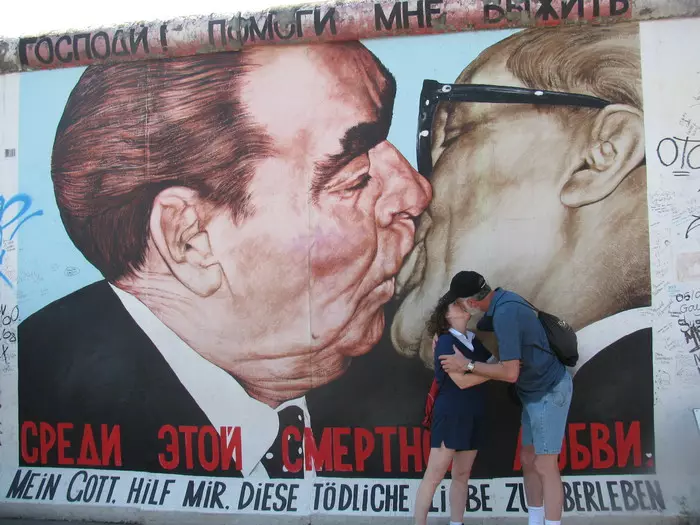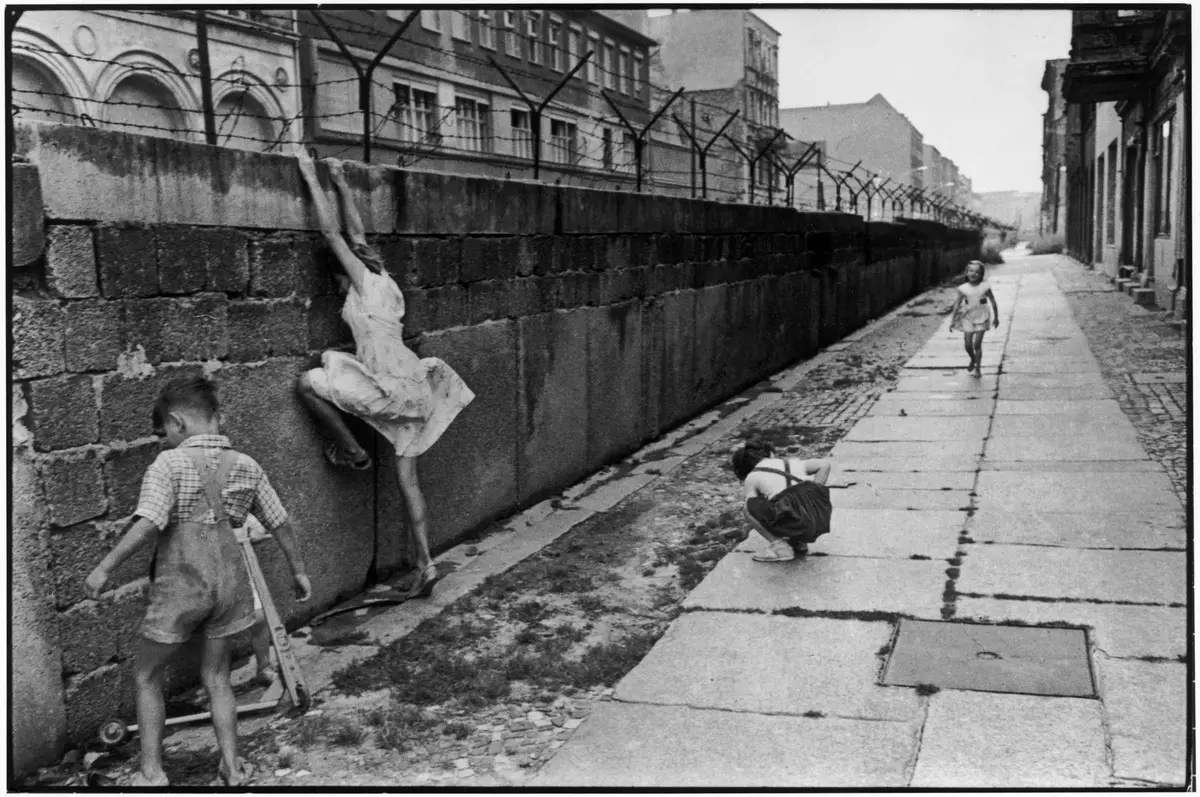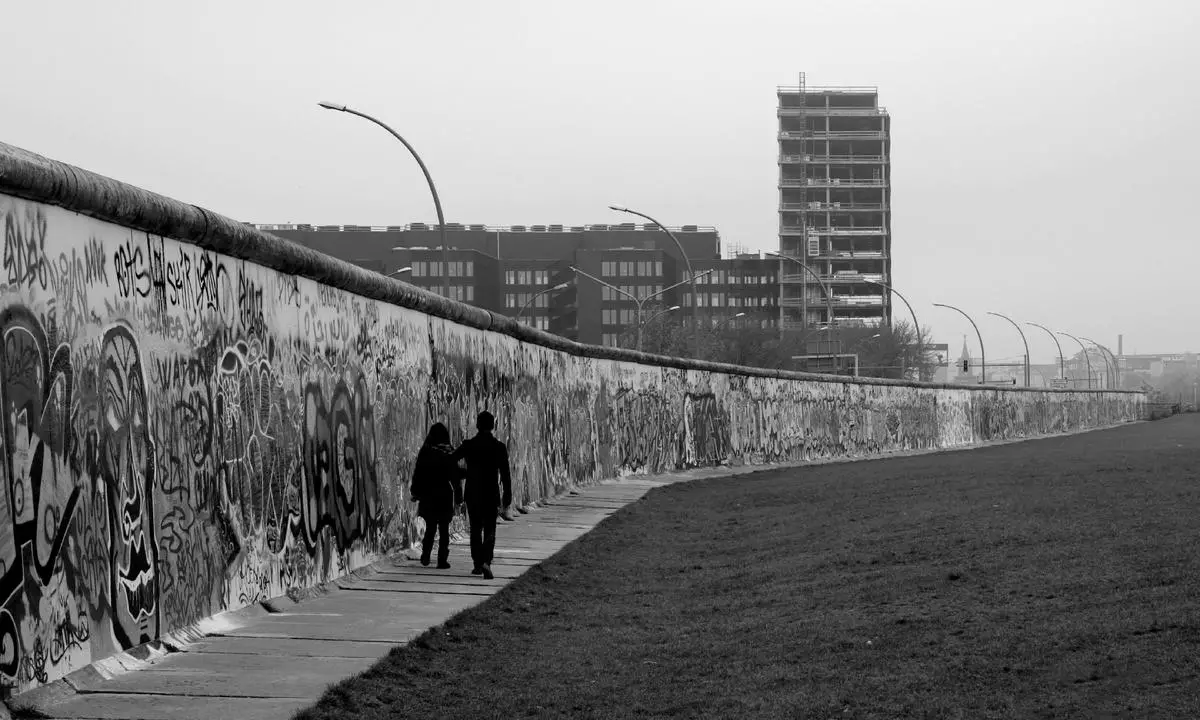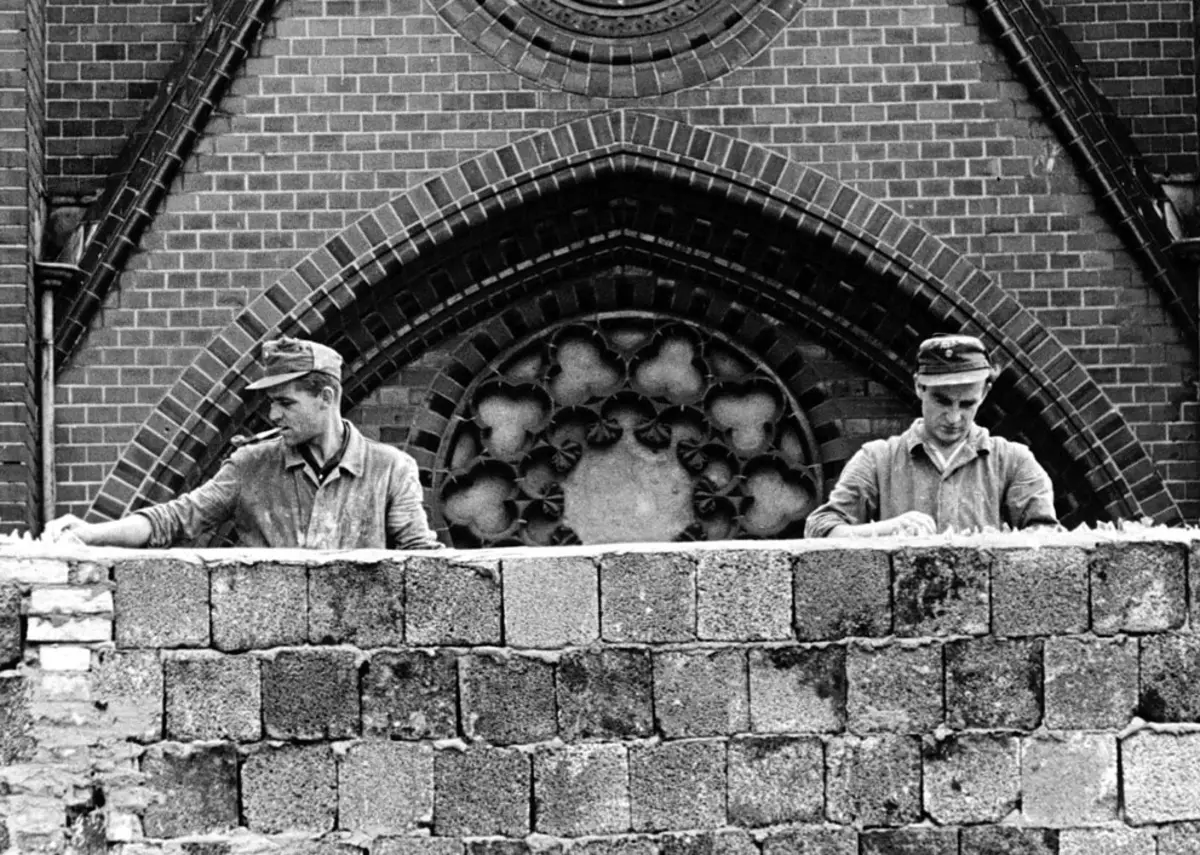
The Berlin Wall was one of the symbols of the Cold War. In East Germany, she was called "Die Anti-Faschistischer Schutzwall" ("Anti-Fascist Protective Wall"). According to representatives of the USSR and the GDR, this wall was needed to prevent the penetration of Western spies to East Berlin, and that the inhabitants of West Berlin do not go to East Berlin for cheap goods that were sold on state subsidies.
In West Germany, they talked about this wall as an attempt to the Soviet Union to stop the migration of Eastern Berliners to West Berlin. So, today, few people know about the sign wall.1. She did not share Eastern and West Germany
Among people are a common misconception that the Berlin Wall shared Eastern and West Germany. This is rooted incorrectly. Berlin Wall separated only Western Berlin from East Berlin and the rest of East Germany (Western Berlin was in East Germany). To understand how Western Berlin was in East Germany, first need to understand how Germany was divided after the war. By the end of World War II, the Allies agreed to divide Germany into four zones of influence: the United States, Great Britain, the Soviet Union and France.

Berlin the same (which was in the zone controlled by the Soviet Union) was also divided into four sectors distributed among allies. Later, disagreements with the Soviet Union led to the fact that the United States, the United Kingdom and France united their zones, forming West Germany and West Berlin, and East Germany and East Berlin remained for the Soviet Union.
The length of the internal boundary between Western and East Germany was more than 1,300 kilometers, which eight times the length of the Berlin Wall (154 kilometers). In addition, only 43 kilometers of the Berlin Wall actually separated East Berlin from West Berlin. Most of the wall separated West Berlin from the rest of East Germany.
2. In fact, there were two walls
Today, few people remember that the Berlin Wall was not one wall, but two parallel walls located at a distance of 100 meters from each other. However, the one that everyone considers Berlin, was closer to East Berlin. Work on the construction of the first wall began on August 13, 1961, and began to build a second wall in a year.

Between the two walls was the so-called "strip of death", where any intruder could immediately shoot. The buildings inside the "Strip of Death" were destroyed, and the whole area was thoroughly aligned and falling asleep with small gravel to identify traces of any fugitives. Also on both sides of the strip after certain intervals, spotlights were installed to prevent escape at night.
3. Church that stood between two walls
Inside the "Strip of Death", the East German and Soviet authorities destroyed all the buildings, with the exception of the so-called reconciliation church. Parishioners could not get into it, as the church was in the forbidden zone. The story associated with this church is quite interesting. After the separation of Berlin, the area around the church fell right on the border between the French and the Soviet sectors. The church itself was in the Soviet sector, and her parishioners lived in the French sector. When they built a Berlin wall, she separated the church from the flock. And when the second wall was completed, the few remaining parishioners living in the Soviet sector were also closed access to the temple.

In West Berlin, the abandoned church was promoted as a symbol of oppression of the Soviet Union of Eastern Berliners and Eastern Germans. The church itself soon became a problem for the East German police, since it was necessary to constantly patrol. As a result, on January 22, 1985, it was decided to demolish it to "improve safety, order and purity."
4. How the wall influenced the subway
Although the Berlin Wall was overhead, she touched on the metro in Berlin. After the separation of Berlin, the metro station on both sides passed under the management of the West and the USSR. It quickly became a problem, because trains passing between two points in West Berlin, sometimes it was necessary to pass through the stations near the Eastern Berlin. To avoid shoots and mixing among citizens of both parties, the eastern Berliners were banned from entering the stations through which Western trains were passing. These stations were sealed, surrounded by barbed wire and alarm. Trains from Western Berlin also did not stop at the "Eastern" stations. The only station in East Berlin, on which they stopped, was Friedrichstras, intended for Western Berliners heading to East Berlin. West Berlin recognized the existence of a subway in East Berlin, but on the maps these stations were labeled as "stations on which the trains do not stop". In East Germany, these stations were completely removed from all maps.5. A small "Berlin Wall" divided the village
After the separation of Germany, the richwell of Tannbach, flowing through the village of Möndlaroit, located on the border of modern Bavaria and Thuringia, was used as the border between the US controlled zones and the Soviet Union. Initially, the villagers did not understand that part of Möldlaroit is in Germany, and the other in the GDR, as they could freely cross the border to visit family members in another country. Wooden fence, erected in 1952, partly limited this freedom. Then, in 1966, this freedom was limited even more when the fence was replaced by cement plates with a height of 3 meters - the same that was used for the separation of Berlin. The wall did not allow the village residents to move between two countries, actually separating the family. In the West, this village was called "Little Berlin". However, the plight of rural residents did not end on the wall. Eastern Germany's authorities also added electrical barriers, after which it became difficult to even leave the village. Part of the wall is still worth it, complete with several watchdog towers and posts. And the village itself remains divided between two federal lands.
6. Famous graffiti of kissing presidents
As mentioned above, the Berlin Wall consisted of two parallel walls. From the side of Western Berlin, her immediately after construction began to paint various graffiti. However, from the side of Eastern Berlin, the wall continued to maintain virgin purity, since the Eastern Germans were forbidden to approach her. After the fall of the Berlin Wall in 1989, several artists decided to paint the eastern part of the Berlin Wall of Graffiti. One of the most famous works is depicting the former leader of the Soviet Union of Leonid Brezhnev, which spattered in a deep kiss with the former head of Eastern Germany Erich Honekker. Graffiti is called the "Kiss of Death" and was written by the artist from the Soviet Union by Dmitry Vrubel. Graffiti was recreating the scene of 1979, when both leaders kissed at the celebration of the 30th anniversary of East Germany. This "fraternal kiss" was in fact the usual phenomenon among high-ranking specials of communist states.7. More than 6000 dogs patrolled death
"The strip of death" - the space between the two parallel walls of the Berlin Wall - it was named so not in vain. It was carefully guarded, including thousands of ferocious animals, nicknamed "Wall Dogs". German shepherds were usually used, but other breeds could also be found, such as Rottweilelers and Dogs. No one knows how much dogs were used. In some accounts, the figure of 6,000 is mentioned, while others argue that they were up to 10,000. It is worth noting that the dogs did not wander freely by the defense strip. Instead, each animal was tied to a 5-meter chain attached to a cable of 100 meters long, which allowed the dog to walk parallel to the wall. After the fall of the Berlin Wall of these dogs, they wanted to distribute them to families in Eastern and West Germany. However, the Western Germans were skeptical to acquire such animals, since the media was promoted by "wall dogs" as dangerous animals that could tear a person into pieces.
8. Margaret Thatcher and Francois Mitteran wanted the wall to stay
Initially, the British Prime Minister Margaret Thatcher and French President Francois Mitteran did not support the destruction of the Berlin Wall and the reunification of Germany. When the negotiations on reunion were held at a high level, she said: "We defeated the Germans twice, and now they return again." Thatcher did everything possible to stop the process and even tried to influence the Government of the UK (which was not in accordance with her.) When Thatcher realized that he could not stop the reunification process, she proposed that Germany was reunited after the transition period five years, and not right away. Mittera was disturbed by the people whom he called "bad Germans". He also feared that reunited Germany would be too influential in Europe, even more than with Adolf Hitler. When Mitteran realized that his opposition would not stop reunion, he changed his position and began to support her. Nevertheless, Mitteran adhered to the opinion that Germany can only be monitored in the event that it is part of the Union of European countries, which is known today as the European Union.9. Recently was found for the forgotten part of the wall
Most of the Berlin Wall was demolished in 1989. The remaining parts that are left specifically are the relics of the separation of Germany. However, one part of the wall was forgotten until it was reopened in 2018. The historian Christian Borman stated on the existence of the 80-meter sector of the wall in Schonholz (Berlin's suburbs). In a blog, published on January 22, 2018, Borman told that he actually discovered this part of the wall in 1999, but decided to keep it secret. Now he revealed its existence due to the concerns that the wall is in poor condition and can collapse. The hidden section of the wall is in the shrub between the railway tracks and the cemetery.
10. She still shares Germany today
The separation of Germany and Berlin was not just in the construction of the wall. It was ideology, and its consequences are still felt today. First, West Germany was capitalist, and East Germany was a communist. This in itself affected the policies of each country. East Berlin from West Berlin can be distinguished even in photographs from space made by Astronaut Andre Kyupers at the International Space Station in 2012. It is clearly visible by the former East Berlin with yellow lighting and the former Western Berlin with greenish lighting. A sharp difference was the result of the use of various types of street lamps used in both countries (light in West Germany is more environmentally friendly than in East Germany). Today in East Germany, the average salary is lower than in West Germany. Since many factories in East Germany could not compete with their Western colleagues after reuniting, they just closed. This led to the fact that in West Germany in most industries were forced to increase wages to attract talented workers. The consequence of this is that people seeking to work in the eastern part of the country, prefer to migrate to Western to find it there. Although it led to a decrease in unemployment in East Germany, it also created "brain leakage". If talking about the positive side, East Germany produces less garbage than West Germany. It is also a consequence of the days of communism, when the Eastern Germans bought only that they were absolutely necessary, compared with Western Germans, who were not economical. In East Germany, it is also better to care for children than in West Germany. Eastern Germans also have larger farms.
